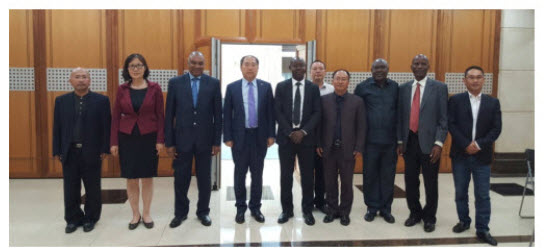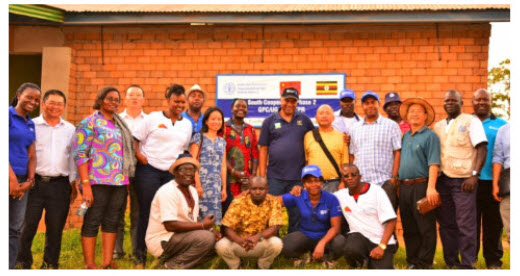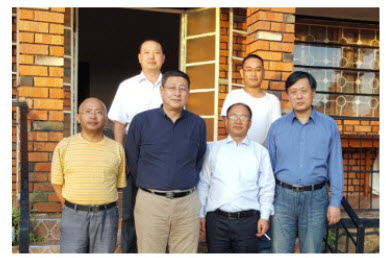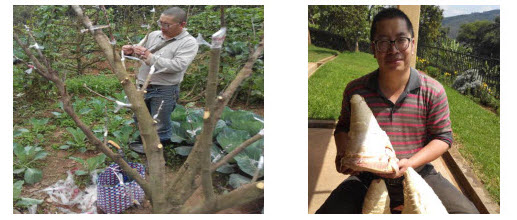REPORT OF THE SECOND PHASE OF CHINA-UGANDA SOUTH-SOUTH COOPERATION PROJECT (Vol.7)
I. Chinese Expert Group were invited to the Reception for China-Uganda Technology Cooperation Project
II. FAO Country Representative in Uganda Mr. Alhaji Jallow Visited Project Site in Kapeeka
III. Director-General of FECC, MOA Mr. Yang Yi Kindly Visited the Expert Group
IV. Work at the Project Sites was Highly Effective
V. Newsletters
I. Chinese Expert Group were invited to the Reception for China-Uganda Technology Cooperation Project
On January 10, 2017, Embassy of the People’s Republic of China in the Republic of Uganda held the Reception for China-Uganda Technology Cooperation Project. Guests invited including Chinese technical experts from the second phase of China-Uganda South-South Cooperation Project, Chinese Medical Team in Uganda, China-Uganda Friendship Agricultural Technological Demonstration Center, Mandela National Stadium and other government construction projects, together with delegates from Ugandan government and its partners. Mr. Zheng Zhuqiang, the new Chinese Ambassador to Uganda attended and addressed the reception. Mr. Pius Wakabi Kasajja, Permanent Secretary of the Ministry of Agriculture, Animal Industry and Fisheries, Uganda, Mr. Alhaji Jallow, FAO Country Representative in Uganda and Mr. Wu Zhiping, leader of Chinese expert group attended the reception as the representatives of China-Uganda South-South Cooperation Project.
Mr. Alhaji Jallow introduced implementation and major achievements of the second phase of China-Uganda South-South Cooperation Project at the reception. He pointed out that China-Uganda South-South Cooperation Project will propel the sustainable development of agricultural and business patterns in Uganda through the integration among agricultural technology transfer, agricultural investment and trade promotion. The SSC Project has set up platforms for governments and companies of China and Uganda, supported and promoted investment in the sustainable agriculture and extended value chain of agriculture. Therefore it is consistent with Uganda’s strategic plan of agriculture and has effectively advanced the social and economic development in rural areas of Uganda. Remarkable achievements have been made in the Project, which has become the paradigm for FAO to implement South-South Cooperation projects in other African countries. Mr. Pius Wakabi Kasajja, Permanent Secretary of the Ministry of Agriculture, Animal Industry and Fisheries, Uganda, reviewed the past agricultural assistance from China to Uganda, commended the contribution of the SSC Project to Uganda’s agricultural development and hoped for further mutual cooperation in agricultural sector with China.
Ambassador Zheng Zhuqiang has paid much attention to the process of the SSC Project since he assumed his new duties in December 2016. Ambassador Zheng listened to the work report of Mr. Wu Zhiping, the leader of Chinese expert group. While showing solicitudes to experts about living conditions, safety and health, Ambassador Zheng raised his expectations. First, to keep political vigilance, give priority to friendly cooperation and establish the brand image of the SSC Project. Second, to integrate the multilateral South-South Cooperation Projects with the Agricultural Technological Demonstration Center so as to make technological assistance more effective. Third, to consolidate and extend outcomes of the Project. In the end, Ambassador Zheng said that he would visit project sites if possible.

Figure I: Group photo of delegates of the second phase of China-Uganda South-South Cooperation Project and embassy officials
(third to fifth from left: Mr. Alhaji Jallow, FAO Country Representative in Uganda, Mr. Zheng Zhuqiang, Chinese Ambassador to Uganda, Mr. Pius Wakabi Kasajja, Permanent Secretary of the Ministry of Agriculture, Animal Industry and Fisheries Uganda)
II. FAO Country Representative in Uganda Mr. Alhaji Jallow Visited Project Site in Kapeeka.
On December 10, 2016, FAO Country Representative in Uganda Mr. Alhaji Jallow led a delegation of FAO to inspect Kapeeka project site and visited demonstration on methane for rural households, organic vegetable production, hybrid rice demonstration, and feed producing of small fish, etc.. The group commended Chinese expert group to combine two phases of the SSC Project into one as so to mobilize multilateral investment with limited fund. The Kapeeka project site will carry out processing demonstration on sweet potato noodles, which will be integrated with Operation Wealth Creation – Uganda in a bid to build Kapeeka as a center to lead farmers to conduct comprehensive production and operation.

Figure II: Group photo of the delegation of FAO in Uganda and Chinese expert group.
III. Director-General of FECC, MOA Mr. Yang Yi Kindly Visited the Expert Group.
From December 6 to 8, 2016, Director-General of FECC, MOA Mr. Yang Yi led a delegation to kindly visit the expert group during the visit in Uganda and checked living facilities of the expert group thoroughly. While commending the expert group for the initial achievements in the work report, Mr. Yang Yi hoped the expert group open their mind, gain more influence, and play a bigger role in promoting Chinese agricultural companies to go abroad in the context of the “Going Out” strategy to facilitate industrial development under China’s 13th Five-Year Plan.

Figure III: Director-General of FECC, MOA Mr. Yang Yi (front row, second from left) kindly visited the expert group.
IV. Work at the Project Sites was Highly Effective.
i. Grain production demonstration at Budaka project site was highly effective.
For one year since the Project was implemented, centered at Budaka District and Butaleja District, the Budaka project has conducted planting demonstration and training on hybrid rice and foxtail millet in around ten districts in eastern and northern regions.
In November 2016, the Rice-Fish Culture Demonstration in Budaka District, covering 1,100 square meters, was completed with 500 kg of rice and 300 kg of fish per mu (1 mu=0.0667 hectares), reaping bumper harvest of both rice and fish.
On January 9, 2017, the on-site rice harvest in Butaleja attracted over 50 people, including local officials and rice growers. According to the field test, the rice yield per mu reached as much as 760 kg for the High-Yield Rice Field Demonstration, 750 kg for the Rice-Fish Culture Demonstration, and the marketable fish achieved individual weights of about 185 g from 10 g. The output of hybrid rice was increased so much that farmers ordered 480 kg seed of hybrid rice on site.
The result of the field test showed that the output per mu reached as much as 577 kg to 760 kg for Chinese hybrid rice grown by demonstration households, and 260 kg for foxtail millet, over three times of the output per mu of the local regular rice (150 kg – 230 kg) and 2 times of average annual output per mu of local millet respectively (Affected by the extended drought, the output of local millet was almost 0 this year.). As such, the grain output and farmers’ income were secured even under the adverse conditions of drought. Butaleja District Local Government wrote to the Ministry of Agriculture, Animal Industry and Fisheries, Uganda for the intention to expand the large-scale cultivation of hybrid rice in Butaleja.
What’s more, the expert group taught over 600 local technicians and farmers, driving more than 80 households to carry out demonstration growing.

Figure IV: The bumper harvest of High-Yield Rice Field Demonstration
Figure V: Farmers were very happy for the good harvest of foxtail millet.
ii. Technological guidance on circular agriculture was conducted at Mbarara project site.
In January 2017, circular agriculture technology was taught by the Chinese expert group at two farms in Mbarara. The expert group recommended on how to improve the feeding management and daily grain formula in accordance with existing facilities and feed ingredients at farms, and instructed farms in building biogas digesters to recycle wastes and pollutants by transferring excrements of livestock and straw as bio-energy, and reusing biogas residue and biogas slurry for grassiness planting to alleviate the shortage of natural grass in dry season.

Figure VI: Chinese expert group was giving technological guidance at farms.
iii. Full mechanization was achieved in China-Uganda Agri-industrial Park.
The mid-November was the beginning of harvest season for rice in China-Uganda Agri-industrial Park in 2016. The local technicians completed harvest with rice combine under the guidance of Shu Zicheng, the agricultural machinery technician. So far, the rice production, from seedling raising and transplanting to harvest, has been fully mechanized. While improving production efficiency, the mechanization was a paradigm in scaling up China’s advanced agricultural technologies and equipments.

Figure VII: Shu Zicheng was instructing mechanized rice harvest.
iv. Training on fruit and vegetable technology was conducted at Kapeeka.
After apple harvest at Kapeeka project site in November 2016, the technician Li Guiqiang started the new round of technology instruction to help solve the problem that adult trees cannot produce fruits. Meanwhile, he conducted the grafting test with hanging bottles on tree branches with leaves so as to increase pollination rates and developed apple bonsai. The vegetable technician Dan Songbai conducted edible investigation on local bamboo shoots so as to diversify vegetable sources while he taught local farmers vegetable technology.

Figure VIII: Li Guiqiang was teaching long grafting.
Figure IX: Dan Songbai was working on fresh edible bamboo shoots.
V. Newsletters
1. From November 23 to 27, 2016, Wang Zhili, the deputy inspector of Sichuan Provincial Agricultural Department, led a delegation to Uganda in a bid to inspect the progress of the second phase of China-Uganda South-South Cooperation Project and the Agri-industrial Park.
2. From December 12 to 14, 2016, Mr. Kafeero Fred, FAO Country Representative in Tanzania led a delegation of 7 project officials of the Ministry of Agriculture, Livestock and Fisheries, Tanzania to Uganda in a bid to learn experience of China-Uganda South-South Cooperation Project from Uganda. It was informed that the Tanzania government was striving for South-South Cooperation projects.
3. Chinese experts and technicians were invited to celebrate the festival at local farmers’ home on the eve of Christmas on December 24, 2016, which mirrored that the China-Uganda South-South Cooperation Project was well received by local farmers.